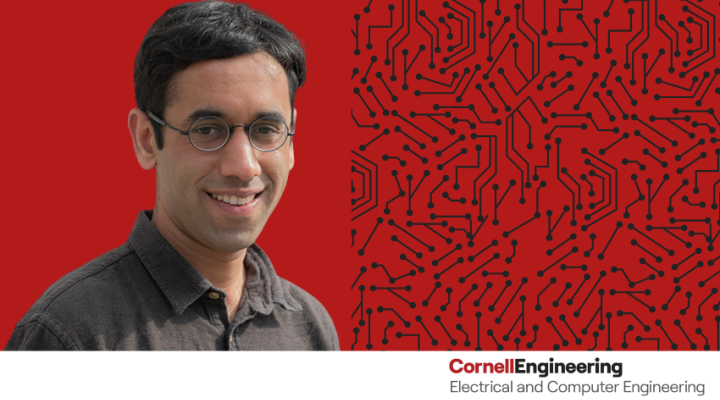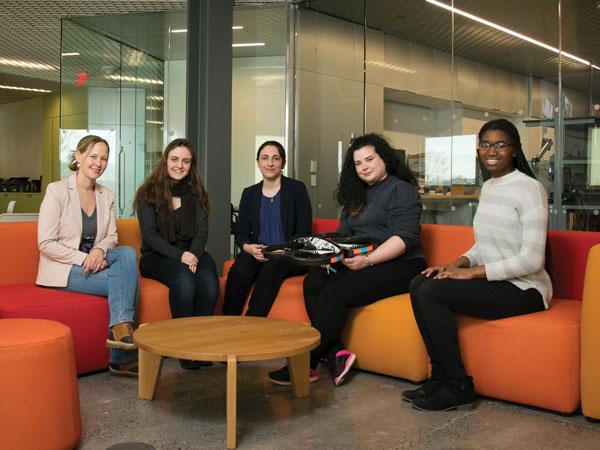When Kirstin Petersen was an undergraduate at the Odense University College of Engineering in Denmark, she was one of just a handful of women in the entire college.
“It was fine, but you certainly experience the full range of comments and you have to have a strong backbone,” says Petersen, who is now an assistant professor in Cornell’s School of Electrical and Computer Engineering (ECE) where 68 of 192 undergraduates are women.
Petersen says she’s thrilled to see ECE’s undergraduate gender ratio trending upward—35 percent women in 2017 versus just 13 percent in 2012. That’s more than twice the national average, according to the American Society for Engineering Education. And for the first time in Cornell Engineering’s history, the college has admitted a class composed of more women than men, with the Class of 2021 being 51% female.
But just like Petersen’s undergraduate days, electrical and computer engineering is still far from a gender-neutral field. And with that gender inequality comes a number of challenges for women—challenges ECE faculty and others are working to eliminate.
CHANGING THE CULTURE
There are several academic studies finding that when male and female scientists engage in team-based activities, they tend to fall into stereotypical behaviors that perpetuate outdated gender roles. So when Petersen heard about some students who were having trouble, she did something that would have been impossible during her undergraduate years—she organized a support community by gathering female students from ECE as well as from the Sibley School of Mechanical and Aerospace Engineering and the Department of Applied and Engineering Physics.
“We really just arranged a coffee hour to let the students know that we are here for them and ready to talk about any issues that may arise. We also made it clear that we are more than happy to support any initiatives they feel would help,” says Petersen, who organized the gathering with Hadas Kress-Gazit, associate professor of mechanical and aerospace engineering. Now the group communicates online, but Petersen and Kress-Gazit remain popular confidants for students who can’t find help among their peers.
“One of the things that could improve the climate in STEM academia is formal training for faculty and TAs to handle situations that involve students who feel discriminated against or uncomfortable in a setting,” says Petersen, who adds that not all classroom leaders are prepared to offer more than just lessons from a textbook. “And it’s not just gender discrimination. It spans political views, religion, even socioeconomics.”
ECE dedicated one of its faculty meetings in the fall semester to diversity and inclusion by hosting a university program aimed at creating a dialog about the challenges of working and living together in a diverse world.
Petersen also proposes diversity training for undergraduates, noting the value it could bring to Cornell Engineering’s multicultural landscape and the fact that engineering, by nature, requires strong teamwork skills and an appreciation for teammates of all backgrounds.
A FOCUS ON RETENTION
An ongoing challenge in the field of electrical and computer engineering has been the retention of female students. Studies and surveys point to a number of causes, one of which is that women, more than men, seek to have a societal impact through their work. And while electrical and computer engineering provides many pathways to effect change, it’s a broad discipline in which societal impact, from an outsider’s perspective, isn’t as evident as fields that have had more success attracting women, such as environmental and biomedical engineering.
“That’s actually a pretty challenging thing to overcome,” says Huili Grace Xing, professor of electrical and computer engineering. One solution is to recruit women from other engineering disciplines, which Xing has been in a unique position to do. She also holds a professorship in Cornell’s Department of Materials Science and Engineering (MSE), which has about equal undergraduate gender representation. Her research combines both fields and she’s used that opportunity to introduce electrical engineering concepts to materials science students.
“The MSE undergraduates perceive us as their parent faculty, so they feel free to approach us and to do work in the lab. We always say ‘yes’ and our door is always open,” says Xing. “We help them to develop early-learning initiatives or research-experience programs to have them funded if they’re interested in pursuing financial aid.”
One field that has been particularly competitive with electrical and computer engineering is computer science. “In computer science, you work primarily with code and a computer. You don’t necessarily work with hardware and hardware sometimes is perceived as a boys thing,” says Xing.
Christina Delimitrou, assistant professor of electrical and computer engineering and a member of the Computer Systems Laboratory, says the solution is to engage students as undergraduates and create positive experiences for them.
“I think the best way to increase the fraction of women and underrepresented minorities in general, is to get them to do research from earlier on. Engage them in research and then convince them to stay for graduate studies,” says Delimitrou, who has six women in her research group earning doctoral, master’s and bachelor’s degrees. “Essentially, it is a positive feedback loop. Once the new generation of students come in, they see many women in the graduate and undergraduate population, feel less isolated and engage in research themselves.”
Xing agrees that providing role models and mentorship is key to retention.
“It’s not just faculty, but also with more women graduate students and fellow undergraduate students supporting each other, it leads to lot more open discussions,” says Xing.
MOVING FORWARD
Recruiting women faculty to ECE is also a priority for the school. Currently, six of ECE’s 40 faculty members are women, five of whom were hired within the last three years. Future recruiting efforts will be conducted with Professor Alyssa Apsel in the director’s seat. Apsel is the school’s longest-tenured female faculty member and will become director in July 2018.
Xing says just as students can find strength and mentorship through faculty, professors can also find inspiration in their colleagues. That’s partly why she co-chairs Cornell Engineering’s Women in Science and Engineering group, which advocates for gender equality in a number of ways, including through faculty hiring.
At a recent meeting of the group, Xing invited Cornell Engineering’s senior associate dean for diversity and faculty development to give a report on faculty hiring, including how many women were interviewed and how many received offers.
“We’re trying to push this kind of transparency, at least to educate ourselves, because when our groups are educated we can come up with better, more constructive feedback,” says Xing, who quipped that STEM faculty work best with facts and data.
Women in Science and Engineering is just one example of support groups available to women in ECE and other schools at Cornell Engineering. Others include the Society of Women Engineers and Women in Computing at Cornell. There are also travel funds designated for women graduate students and starting in 2018, a monthly “spotlight” will recognize an outstanding female student, postdoctoral researcher or faculty member in ECE.
“I think we’re doing well,” says Petersen of the effort to tackle gender issues in electrical and computer engineering. “We have more women than ever but there’s still some problems left and we need to address them to clear the path for the next generation of more diverse engineers.”



